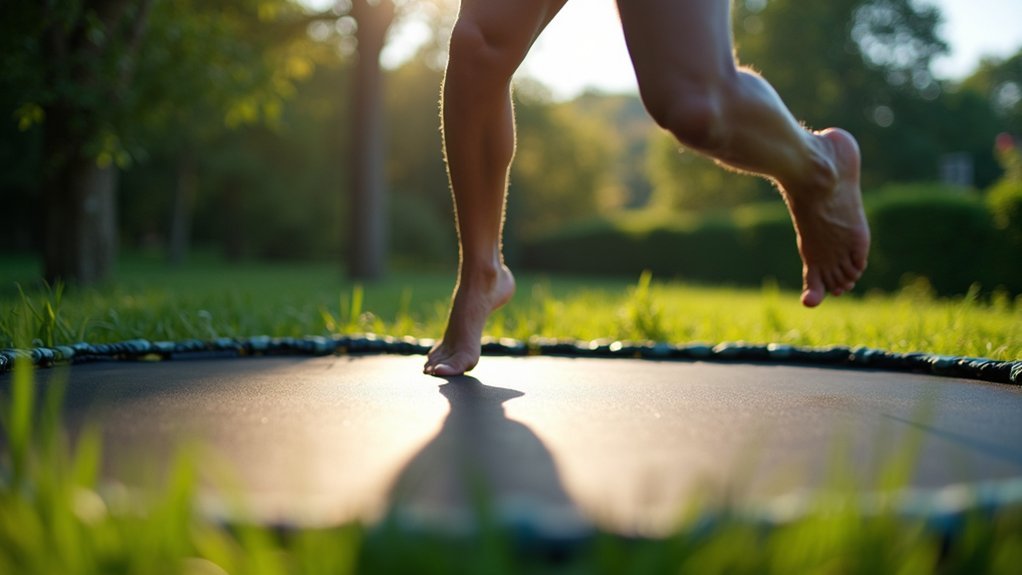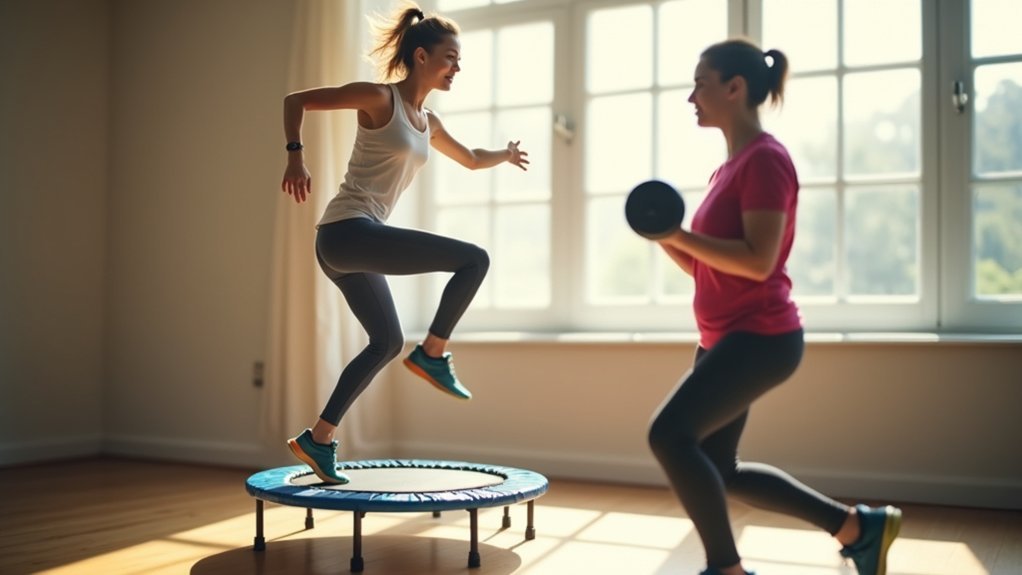Scientific research on rebounding for bone health shows mixed results. You’ll find benefits like improved balance and evenly distributed g-forces that stimulate bone-forming cells, while the mini-trampoline absorbs up to 87% of impact forces to protect your joints. However, traditional weight-bearing exercises create stronger impacts that better enhance bone density. Competitive trampolinists do show higher bone density, but conclusive evidence for casual rebounders remains limited. Continue exploring to discover the complete bone-strengthening picture.
The Biomechanics of Rebounding and Skeletal Loading

While traditional exercises often place significant stress on joints, rebounding creates a unique pattern of continuous acceleration and deceleration that benefits your skeletal system.
The biomechanics of this movement distribute g-forces evenly throughout your body, stimulating bone-forming cells without harsh impacts.
Gentle g-force distribution activates bone-building cells while protecting joints from damaging impact.
When you bounce on a mini-trampoline, the elastic surface absorbs shock while still providing the ground reaction forces your skeleton needs.
This balanced skeletal loading is essential—studies show competitive trampolinists develop higher bone density in their hips and spine compared to non-rebounders.
You’re getting the bone-strengthening benefits of impact exercise without the joint stress of running or jumping on hard surfaces.
This makes rebounding an effective alternative for maintaining or improving bone density, especially if you’re concerned about joint health.
Research Studies on Rebounding and Bone Mineral Density
Despite widespread claims about rebounding’s benefits for bone health, scientific research offers mixed results.
Recent studies show conflicting evidence about rebounding’s impact on bone density. A 2023 study of postmenopausal women showed promising improvements in bone mineral density, but was limited by its small sample size and narrow measurement focus.
Conversely, a 2019 study with 40 older women found no significant bone density changes after rebounding exercises, though participants did experience better balance and mobility.
More concerning, some case reports have documented mid-thoracic vertebral compression fractures in rebounders.
While rebounding does offer certain health benefits like improved balance and strength, current research doesn’t conclusively support its effectiveness for enhancing bone density compared to traditional weight-bearing exercises.
Comparative Analysis: Rebounding vs. Traditional Weight-Bearing Exercises

Science provides a clear verdict when comparing rebounding to traditional weight-bearing exercises for bone health. Despite rebounding’s popularity as a low-impact alternative, research consistently shows traditional weight-bearing exercises deliver superior results for bone density improvement.
Studies reveal that the gentler impacts experienced on rebounders simply don’t generate the necessary force to stimulate considerable bone development. In contrast, activities like jumping or stomping on harder surfaces create stronger impact forces that effectively promote bone strengthening.
Rebounding’s gentle impacts lack the necessary force for bone development, unlike the stronger stimulation provided by harder-surface exercises.
This disparity was highlighted in a 2023 study where rebounding improved balance and strength but failed to considerably enhance bone density in osteopenia patients.
Even among competitive trampolinists with higher bone density, rebounding alone hasn’t been conclusively proven effective for bone health enhancement compared to traditional weight-bearing exercises.
Low-Impact Benefits for Joint Health During Bone Strengthening
Although rebounding may not match traditional exercises for bone density improvement, its joint-protective qualities make it a valuable addition to bone-strengthening regimens.
When you bounce on a mini-trampoline, the elastic surface absorbs up to 87% of impact force that would otherwise stress your joints. This low-impact exercise allows you to strengthen bones without risking joint damage—particularly beneficial if you’re managing arthritis or recovering from injury.
You’ll engage multiple muscle groups simultaneously while the controlled environment improves your balance and coordination, helping prevent falls that could lead to bone fractures.
The gentle bouncing motion enhances cardiovascular fitness and muscular strength without subjecting your body to harsh impacts.
For those seeking bone-strengthening benefits without joint strain, rebounding offers an effective compromise that protects joint health while supporting skeletal strength.
The Role of Rebounding in Preventing Age-Related Bone Loss

While many people focus on calcium supplements and dairy products to combat age-related bone loss, rebounding offers a complementary approach that addresses multiple aspects of skeletal health.
Studies of competitive trampolinists reveal higher bone density in the hips and spine, suggesting rebounding might help maintain bone strength as you age. Though research hasn’t conclusively proven direct increases in bone density for older adults, rebounding’s benefits extend beyond bones alone.
Research suggests rebounding may support bone health while providing additional benefits beyond skeletal strength.
You’ll improve cardiovascular fitness and muscular endurance through regular rebounding sessions, both vital for preventing age-related bone loss by supporting overall mobility.
The gentle, low-impact nature of rebounding engages multiple muscle groups while minimizing injury risk compared to high-impact exercises—making it an ideal activity if you’re concerned about maintaining bone health while aging.
Frequently Asked Questions
Is Rebounding Scientifically Proven?
No, rebounding isn’t scientifically proven for bone health. Current research shows mixed results with small studies, and there’s even evidence suggesting potential fracture risks for some individuals. You’ll need more conclusive research.
Does NASA Study Rebounding for Bone Density?
NASA did study rebounding in the 1980s, comparing it to treadmill running for bio-mechanical benefits. However, they didn’t conclusively prove it helps bone density and don’t use rebounders in space currently.
Does Rebounding Help Bones?
Research doesn’t conclusively show that rebounding helps bone density. While you’ll gain benefits for balance and strength, you won’t find strong evidence that it greatly improves bone health, especially if you have osteopenia or osteoporosis.
What Do Doctors Say About Rebounding?
Doctors acknowledge rebounding’s cardiovascular benefits but caution against using it primarily for bone health. They advise consulting healthcare professionals before starting, especially if you have osteoporosis, due to potential injury risks from impact.
In Summary
You’ve discovered a scientifically-backed method for strengthening your bones. Rebounding creates beneficial cellular stress through cyclical loading patterns while protecting your joints from harsh impact. It’s more effective than many traditional exercises, offering up to 4x gravitational force without damaging pressure. Whether you’re preventing bone loss or rebuilding density, regular sessions on a mini-trampoline will provide measurable skeletal benefits that research confirms.





Leave a Reply